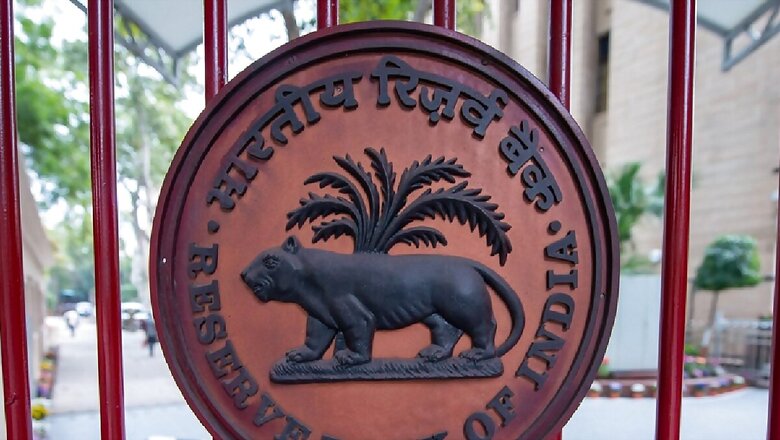
views
RBI MPC August 2024 Highlights: The RBI MPC on Thursday, August 8, kept the key repo rate unchanged for the 9th consecutive time at 6.5 per cent, with the majority (4 out of 6 members) maintaining the stance of ‘withdrawal of accommodation’. The repo rate decision has been taken with a 4:2 majority.
The RBI has kept FY25 GDP projection unchanged at 7.2 per cent. Its FY25 CPI inflation projection also stood the same at 4.5 per cent.
While announcing the bi-monthly monetary policy statement on Thursday, RBI Governor Shaktikanta Das said, “India’s growth remains strong, inflation is on a declining trajectory.”
Global near-term outlook looks positive, medium-term outlook looks challenging, he said.
RBI’s Status Quo on Repo Rate, SDF, MSF
The RBI’s monetary policy committee on August 8 kept the repo rate unchanged for the ninth time in a row, at 6.5 per cent. The RBI MPC also kept the SDF unchanged at 6.25 per cent, and MSF and Bank Rates maintained at 6.75 per cent. The SDF is the lower band of the interest rate corridor, while the MSF is the upper band.
The reverse repo rate stands at 3.35 per cent.
The repo rate is the rate at which the RBI lends money to the commercial banks, whereas the reverse repo rate on commercial banks’ deposits with the RBI.
The cash reserve ratio (CRR) stands at 4.5 per cent and the statutory liquidity ratio (SLR) stands at 18 per cent.
FY25 GDP Growth Projection Retained At 7.2%
The RBI has also kept the GDP growth projection for the current financial year 2024-25 unchanged at 7.2 per cent. In the previous policy review in June, the central had raised the FY25 economic growth rate to 7.2 per cent, from 7 per cent earlier.
“Real GDP growth for 2024-25 is projected at 7.2 per cent, with Q1 at 7.1 per cent; Q2 at 7.2 per cent; Q3 at 7.3 per cent; and Q4 at 7.2 per cent. Real GDP growth for Q1:2025-26 is projected at 7.2 per cent,” the RBI governor said in his monetary policy statement.
FY25 CPI Inflation Forecast Unchanged At 4.5%
Stating that the RBI remains vigil on any upside risk inflation, especially food inflation, Governor Shaktikanta Das kept the CPI inflation for 2024-25 same at 4.5 per cent.
He said, “MPC may look through high food inflation if it is transitory but in an environment of persisting high food inflation, as we are experienceing now, the MPC can not afford to do so. It has to remain vigilant to prevent spillovers or second round effects from persisting food inflation and preserve the gains made so far in monetary policy credibility.”
Das said, “Assuming a normal monsoon, and taking into account the 4.9 per cent inflation print in Q1, CPI inflation for 2024-25 is projected at 4.5 per cent, with Q2 at 4.4 per cent; Q3 at 4.7 per cent; and Q4 at 4.3 per cent. CPI inflation for Q1:2025-26 is projected at 4.4 per cent.”
Additional Measures by RBI:
UPI Limit for Tax Payments Raised from Rs 1 Lakh to Rs 5 Lakh
In order to ease tax payments by consumers through unified payment interface (UPI), the RBI on Thursday decided to enhance the limit for tax payments through UPI from Rs 1 lakh to Rs 5 lakh per transaction.
Currently, the transaction limit for UPI is Rs 1 lakh except for certain category of payments which have higher transaction limits.
Public Repository of Digital Lending Apps
RBI Governor Shaktikanta Das also announced to create a public repository of digital lending apps (DLAs) deployed by its regulated entities. It is aimed at addressing the problems arising from unauthorised digital lending apps (DLAs).
“The regulated entities (REs) will report and update information about their DLAs in this repository. This measure will help the consumers to identify the unauthorised lending apps,” Das said.
The Reserve Bank has taken several measures for the orderly development
of the digital lending ecosystem in India.
CIBIL, Experian Reports To Be Updated Faster
The RBI on Thursday proposed to increase the frequency of reporting of credit information to a fortnightly basis or at shorter intervals.
“The availability of accurate credit information is vital for both lenders and borrowers,” the RBI governor stated.
Currently, lenders are required to report credit information to credit information companies (CICs) on a monthly basis or at such shorter intervals as may be agreed between the lenders and the CICs.
CICs in India include CIBIL, Experian, and Equifax.
Consequently, borrowers will benefit from faster updation of their credit information, especially when they repay their loans. The lenders, on their part, will be able to make better risk assessment of borrowers, he added.
Introduction of ‘Delegated Payments’ through UPI
The RBI proposed to introduce a facility of “Delegated Payments” in UPI. This would enable an individual (primary user) to allow another individual (secondary user) to make UPI transactions up to a limit from the primary user’s bank account without the need for the secondary user to have a separate bank account linked to UPI. This will further deepen the reach and usage of digital payments.
Continuous Clearing of Cheques
The RBI proposed to reduce the clearing cycle by introducing continuous clearing with ‘on-realisation-settlement’ in CTS. This means that cheques will be cleared within a few hours on the day of presentation. This will speed up cheque payments and benefit both the payer and the payee.
At present, cheque clearing through Cheque Truncation System (CTS)
operates in a batch processing mode and has a clearing cycle of up to two working days.


















Comments
0 comment